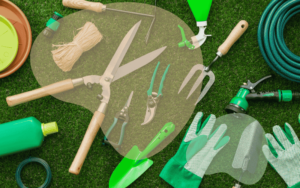Proper garden tools storage is crucial for maintaining the longevity and performance of your gardening tools. Not only does it protect your tools from damage, but it also makes them easier to find and use. By organizing your tools efficiently, you can save time and effort when tackling your next gardening project.
Overview of Garden Tools Storage Solutions
There are numerous storage solutions available for gardening tools, both indoors and outdoors. The best option for you will depend on the size of your tool collection, the available space in your home or garage, and your budget. Additionally, a well-thought-out storage plan can prevent unnecessary wear and tear on your tools, ensuring they last for years to come.
Indoor Storage Options
Tool Sheds and Garages
If you have a dedicated tool shed or garage, it’s an ideal place to store your gardening tools. Install shelves, hooks, and pegboards to keep your tools organized and accessible. Weatherproof storage bins are excellent for protecting tools from moisture and dust. If your garage is prone to dampness, consider using a dehumidifier or moisture-absorbing products.
Basement Storage
Basements can be a great place to store gardening tools, especially if they are dry and clean. However, be mindful of potential moisture and temperature fluctuations that can damage tools over time. Elevate tools off the floor and use rust-proof containers for added protection.
Attic Storage
While attics can be used for tool storage, they often have temperature and humidity extremes. Use weatherproof storage containers and elevate tools off the floor to mitigate damage. Consider climate-controlled solutions if available.
Indoor Workshops
If you have an indoor workshop, you can create a dedicated storage area for your gardening tools. Pegboards, tool racks, and cabinets help keep tools organized and within reach. A workbench with built-in storage can provide additional utility.
Outdoor Storage Options
Outdoor Tool Sheds
Outdoor tool sheds are specifically designed for storing gardening tools and equipment. Customize your shed with shelves, hooks, and workbenches for optimal organization. Ensure your shed is weather-resistant to protect against rain and humidity.
Garden Sheds
Garden sheds provide versatile storage solutions for gardening tools and larger equipment like lawnmowers and wheelbarrows. They often come with pre-installed shelves and hooks for better organization.
Patio Storage Cabinets
Patio storage cabinets are ideal for smaller gardening tools such as hand trowels, pruning shears, and gloves. These weather-resistant cabinets provide convenient access to tools while blending into outdoor decor.
Wall-Mounted Storage Racks
Wall-mounted storage racks are a space-saving solution for organizing gardening tools. Install them in your garage, shed, or workshop to keep tools off the floor and within easy reach.
Organizing Your Tools
Categorizing Tools
Categorizing tools by type or function can make them easier to locate. Group tools by tasks such as planting, weeding, pruning, or lawn care.
Using Tool Belts and Vests
Tool belts and vests keep essential tools within reach while working in the garden. This can save you trips back to the shed or garage.
Creating a Tool Inventory
Keep track of your tools by creating an inventory. Use a spreadsheet or simple checklist to document your tools and identify missing or damaged items.
Labeling Storage Bins and Drawers
Labeling storage bins and drawers helps you quickly find the tools you need. Use clear, durable labels that won’t fade over time.
Protecting Your Tools
Cleaning Tools Before Storage
Clean your tools before storage to prevent rust and corrosion. Remove dirt, debris, and plant matter using a brush or cloth. For stubborn grime, use a mild detergent and water, then dry thoroughly.
Applying Lubricants
Apply a light coat of lubricant to metal tools to protect them from rust. Silicone-based or specialized tool lubricants work well for this purpose.
Preventing Rust and Corrosion
Store tools in a dry environment to prevent rust. Avoid placing tools directly on concrete floors, as concrete can retain moisture. Use racks, shelves, or hangers to elevate tools off the ground.
Storing Tools in a Dry Environment
As mentioned earlier, keeping tools in a dry space is essential. If your storage area is damp, consider using silica gel packs, moisture absorbers, or a dehumidifier to control humidity levels.
Seasonal Storage Tips
Winter Garden Tools Care
Before winter, clean and dry your tools thoroughly. Sharpen blades, apply rust preventatives, and store tools in a dry, climate-controlled environment. Cover larger tools with protective sheaths or cloths.
Summer Garden Tools Care
Inspect tools for damage or wear before spring. Sharpen blades, replace broken handles, and clean any rust or grime. Reapply lubricants to metal parts as needed.
Preparing Tools for Spring and Fall
At the start of each gardening season, clean and organize your tools. Ensure they’re in good working condition by replacing worn parts and performing routine maintenance.
Advanced Tips for Budget-Friendly Storage Solutions
- Repurpose household items like PVC pipes, old crates, or wooden pallets to create DIY storage racks. For example, cut PVC pipes into sections to hold individual tools upright.
- Use magnetic strips mounted on walls to hold metal tools securely.
- Hang a pegboard and customize it with hooks for a low-cost, space-saving solution.
- For small spaces, consider collapsible or foldable storage bins that can be tucked away when unused.
If you following these tips, you can ensure that your gardening tools remain in top condition for years to come. Proper storage, cleaning, and maintenance will save you time and money while enhancing your gardening experience. Whether you’re a beginner or a seasoned gardener, an organized approach to tool storage makes every gardening project more enjoyable and efficient.



